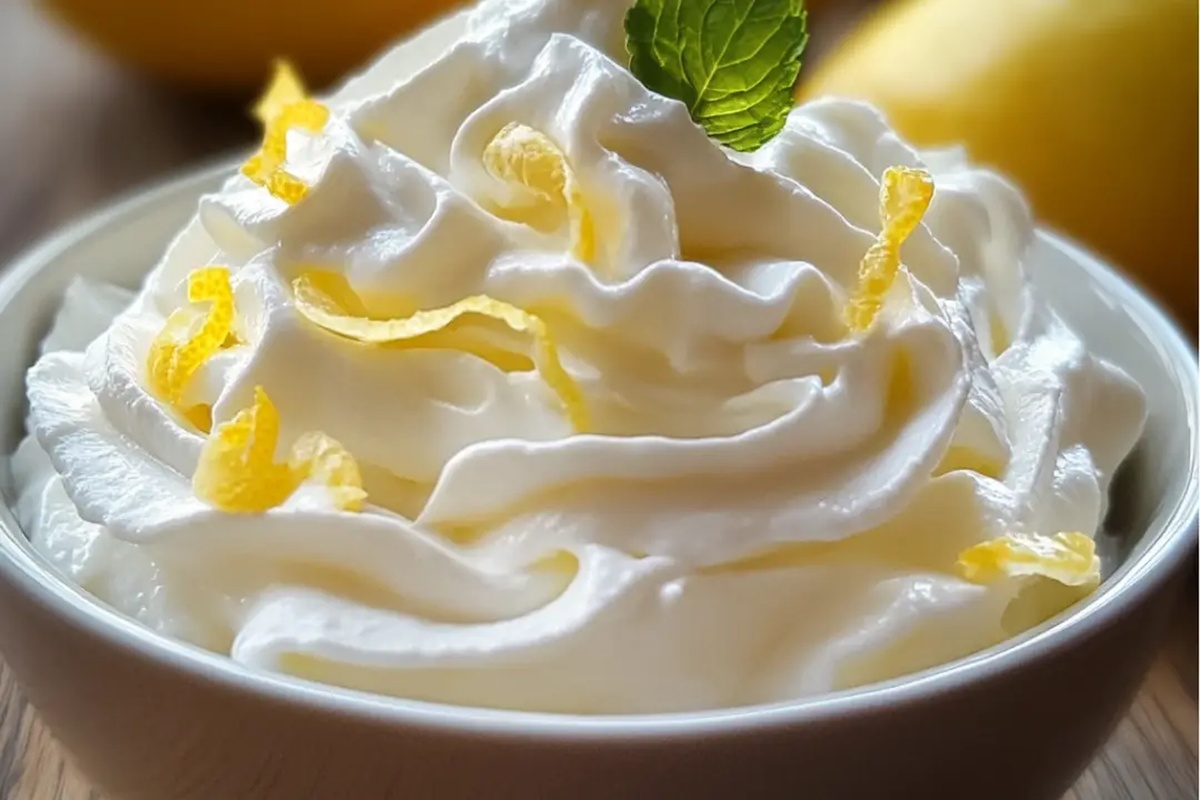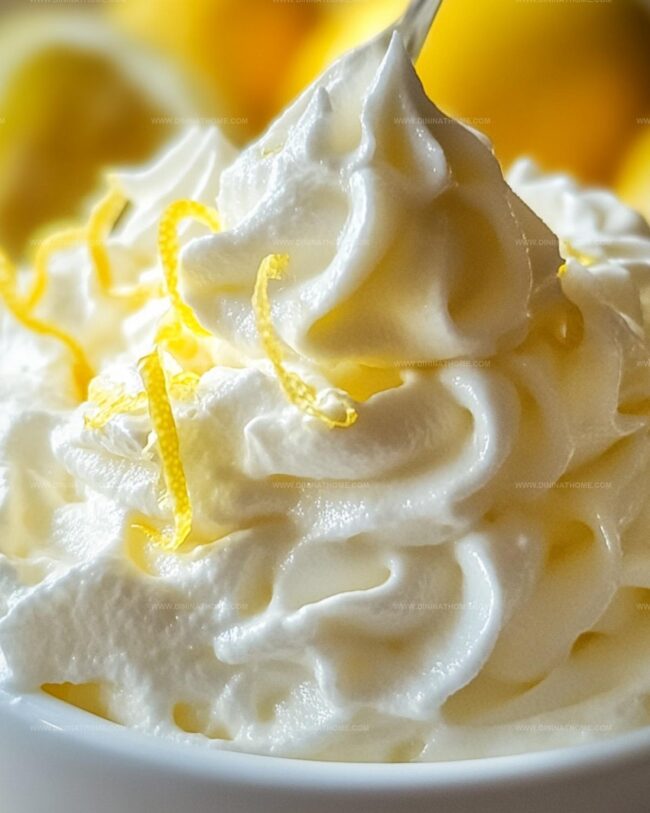Heavenly Lemon Whipped Cream Recipe: A Zesty Sweet Topping
Crafting a delectable lemon whipped cream can turn any dessert into a zesty masterpiece.
Clouds of fluffy brightness dance across your palate with each silky spoonful.
Light and airy textures merge with bright citrus notes that spark culinary excitement.
Rich cream transforms into a tangy delight through simple whisking techniques.
Delicate lemon essence infuses traditional whipped cream with unexpected, refreshing dimensions.
Kitchen magic happens when basic ingredients meet strategic preparation.
Surprising your guests becomes effortless with this quick and elegant topping that promises to elevate every sweet moment.
Whipped Lemon Cream That’s Light and Zesty
Lemon Whipped Cream What Goes In
Dairy Base:Citrus Flavoring:Optional Stabilizers:How to Whip Up the Lightest Lemon Cream
Step 1: Chill Your Bowl and Whisk
Select a large metal or glass mixing bowl and place it in the refrigerator for about 15 minutes.
Cold equipment helps the cream whip faster and hold its shape better.
Step 2: Pour the Cream
Remove the chilled bowl from the refrigerator and pour in the heavy cream.
Using an electric mixer, start beating on low speed until the cream becomes slightly frothy and begins to thicken.
Step 3: Zest the Lemon
Using a fine grater, carefully zest a fresh lemon, avoiding the bitter white pith underneath the yellow skin.
Set the lemon zest aside.
Step 4: Boost the Flavor
Add these ingredients to the partially whipped cream:Gradually increase the mixer speed to medium-high and continue beating.
Step 5: Achieve Perfect Peaks
Continue whipping the cream until it forms stiff, glossy peaks that stand up straight when you lift the beaters.
Be careful not to overbeat, which can turn the cream into butter.
Step 6: Serving Suggestions
Transfer the lemon-infused whipped cream to a serving bowl or pipe it onto desserts like:Serve immediately for the freshest texture and brightest flavor.
Whipped Cream Tips with a Bright Lemon Edge
Chill Lemon Whipped Cream for Later
Toppings to Enjoy with Lemon Whipped Cream
Lemon Whipped Cream Add-In Ideas
FAQs
Lemon whipped cream adds a bright, citrusy flavor by incorporating fresh lemon juice and zest, which gives it a tangy and refreshing twist compared to traditional whipped cream.
Fresh lemon juice is recommended for the best flavor and brightness. Bottled juice can work but might taste less vibrant and lack the essential oils found in fresh lemon zest.
The cream is ready when it forms stiff peaks – this means when you lift the mixer beaters, the cream stands up straight without falling over and looks thick and glossy.
You’ll need an electric mixer and a large mixing bowl. A hand mixer or stand mixer both work well for achieving the right whipped cream consistency.
Print
Lemon Whipped Cream Recipe
- Total Time: 5 minutes
- Yield: 4 1x
Description
Silky lemon whipped cream elevates desserts with its zesty, refreshing charm. Elegant clouds of citrus-kissed cream dance across sweet treats, promising a delightful culinary experience you’ll savor.
Ingredients
Main Ingredients:
- 2 cups (473 ml) heavy cream
- 1/2 cup (60 grams) powdered sugar
Flavor Enhancers:
- 2 tablespoons (30 ml) lemon juice
- 2 teaspoons (4 grams) lemon zest
Instructions
- Chill a large mixing bowl and whisk attachment in the freezer for 10-15 minutes to ensure optimal whipping conditions.
- Transfer the cold heavy cream into the chilled bowl and begin whipping at low speed, gradually increasing to medium-high as the cream starts to thicken.
- When the cream develops a soft, billowy texture, sprinkle in the finely grated lemon zest, which will infuse delicate citrus notes throughout the mixture.
- Drizzle the fresh lemon juice into the cream while continuing to whip, watching as the mixture transforms into a light, airy consistency.
- Continue beating until the whipped cream forms sturdy, glossy peaks that hold their shape when the whisk is lifted, being careful not to overbeat and turn the cream grainy.
- Serve immediately or cover and refrigerate for a brief period, knowing the lemon-infused cream will maintain its vibrant texture and bright, tangy flavor for several hours.
Notes
- Chill your mixing bowl and whisk beforehand to help the cream whip faster and hold its shape better.
- Use fresh lemon zest for the most vibrant citrus flavor, avoiding the white pith which can taste bitter.
- Start beating at a lower speed to prevent splattering, gradually increasing to create smooth, stable whipped cream.
- For a lighter texture, fold in the lemon juice and zest gently after whipping to maintain maximum volume.
- Prep Time: 5 minutes
- Cook Time: 0 minutes
- Category: Desserts, Snacks
- Method: Whipping
- Cuisine: American
Nutrition
- Serving Size: 4
- Calories: 300
- Sugar: 15 g
- Sodium: 5 mg
- Fat: 30 g
- Saturated Fat: 18 g
- Unsaturated Fat: 12 g
- Trans Fat: 0 g
- Carbohydrates: 18 g
- Fiber: 0 g
- Protein: 2 g
- Cholesterol: 100 mg





James Walker
Lead Recipe Developer & Culinary Educator
Expertise
Southern Cuisine & Farm-to-Table Cooking, Recipe Development & Testing, Culinary Education & Instruction
Education
School: Auguste Escoffier School of Culinary Arts
Program: Diploma in Culinary Arts and Operations
Focus: Comprehensive training in classical and modern culinary techniques, kitchen operations, and farm-to-table practices.
James didn’t learn cooking from a TV show, he learned it from busy kitchens, family gatherings, and long afternoons spent testing recipes the hard way.
After training at the Auguste Escoffier School of Culinary Arts, he brought his love for real, down-to-earth food to every dish he makes.
At Dining At Home, James loves building recipes that feel familiar but still have something special, like adding a twist to a classic or making a slow Sunday dinner feel brand new.
When he’s not in the kitchen, you’ll probably find him swapping garden tips at the farmers’ market or teaching his daughter how to flip pancakes without a mess (almost).